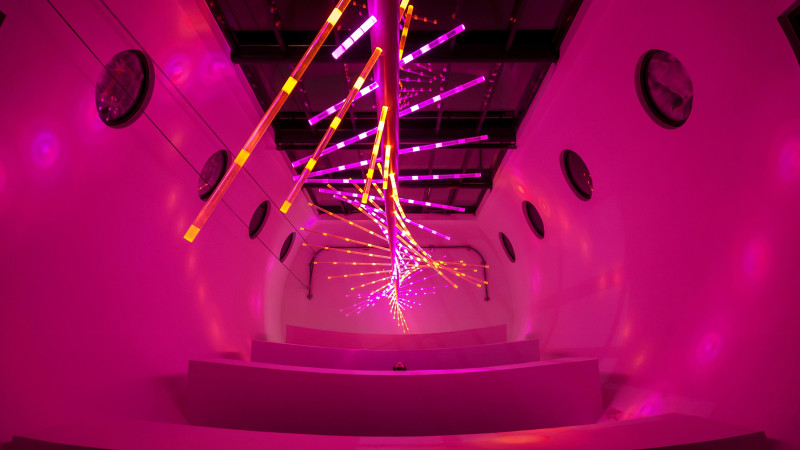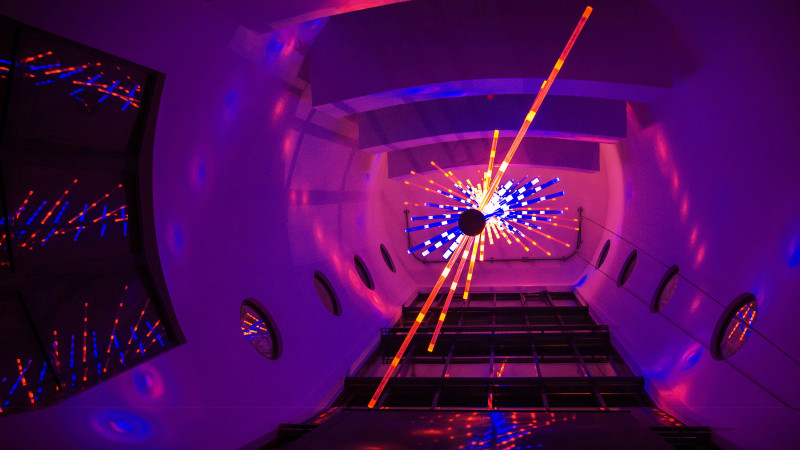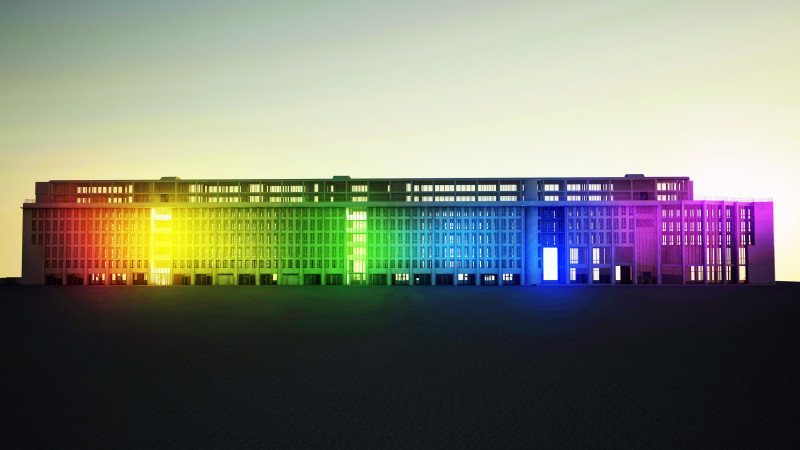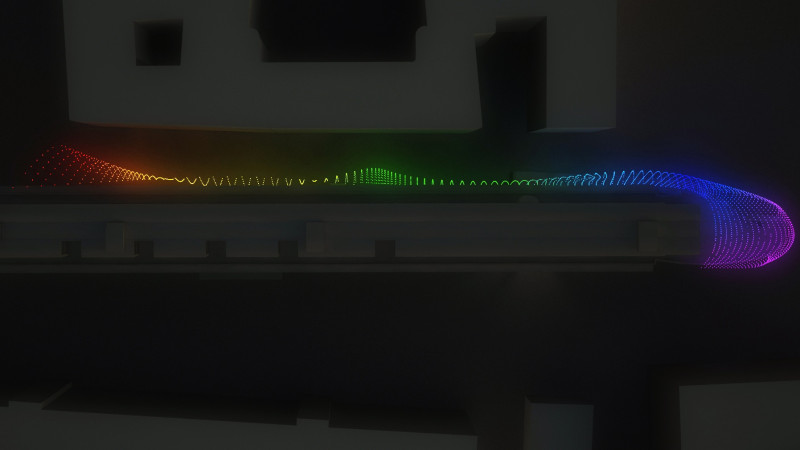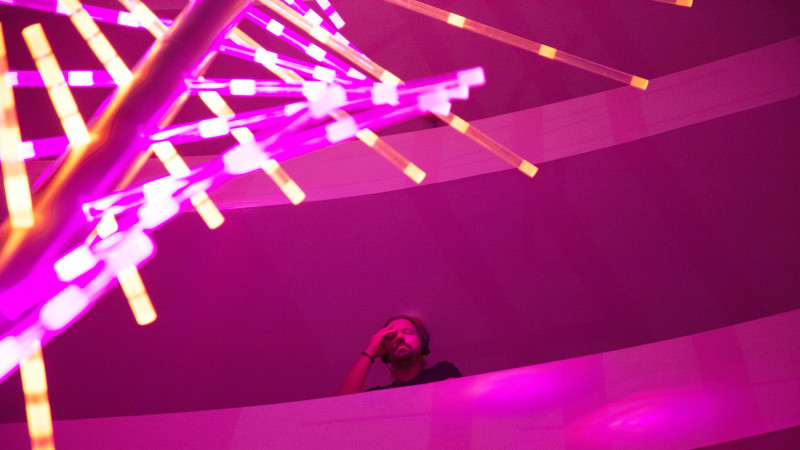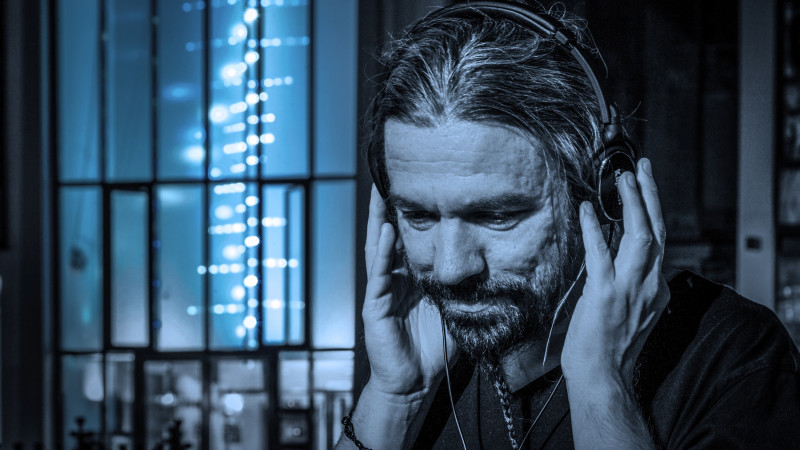AN ART ON BUILDING PROJECT
INTRODUCTION
Vienna/Dresden. A dead house is revived and now opens its doors. The story is quickly told: A vacant property at a prominent, historically burdened location is revitalized with the help of creativity - with the help of art. This is the beginning of a large art-in-building project that shines, sounds and vibrates: The "DNA" of the artist SHA. extends over 150 meters through the entire Living House. The existing architecture continues to evolve with the urban space into a "Holistic Design".
FROM THE PAST
1963: In an arbitrary act of the GDR government, the 600-year-old Sophienkirche, Dresden's only remaining Gothic church, is demolished and replaced by the GDR's largest gastronomic project - a large restaurant, popularly known as the "Fresswürfel". Directly opposite the world-famous Zwinger.
1998: After reunification, the building, which was considered an eyesore, was demolished and replaced by a new building. The so-called "Haus am Zwinger" is built in a modern style by the Austrian architect Heinz Tesar after an international competition. Objections from the local population regarding the historical significance of this site are largely ignored. The property develops tentatively, is only partially occupied, changes hands several times and finally stands empty. A sad sight in a prominent location.
2016: The German property development group Denkmalneu, which specializes in redevelopment properties, acquires the property and, based on the existing building, develops a new real estate concept together with the Viennese artist SHA. called "Das Lebendige Haus" ("The Living House"). Today, a good 50 years after the GDR's despotism, this house attempts to build a sensitive bridge between the past and the future in the present.
TO THE PRESENT
So today this place is being revived after a long slumber. A fairy tale? No ... Reality: The central element of this new reality is "creativity" - a sign of life. Creativity can be felt in many places in this Living House: art permeates the entire building, inside and out. It is an art that was developed especially for this house. The artist SHA. has closely accompanied the creation of the Living House and created the DNA for this building - as an "energetic backbone".
Lights, colors, sounds and vibrations create the special room atmosphere. A glass double helix loops over 150 meters through the entire building. The path leads from the existing architecture to a holistic design. For this DNA resonates in its own time dimension: the possibility of "deceleration" opens a connecting channel between times: From the spirit of Sophienkirche to a new space of reflection in the midst of our high-performance society.
As the artist SHA. puts it, "The intangible value that arises in people is the value of this art."
THE INITIAL POSITION
The brief: revitalize a property with art.
"Wellness for Buildings"
The so-called "Haus am Zwinger" stands in a prominent location directly in the center of the city of Dresden, vis-à-vis the famous Zwinger. The building shows itself as a functional functional building, which could not be used successfully in the past 15 years - practically since its construction.
The German developer group DENKMALNEU, which specializes in redevelopment projects, has acquired the building and is putting the entire complex to creative mixed use. In the process, a novel, holistic design concept is being created together with the Austrian artist SHA.: "Das Lebendige Haus" ("The Living House").
THE IDEA TO A WORK OF ART
"The Living House" implies that there is - or was - also a "Dead House." Thus, broadly speaking, it is about a revival, a kind of awakening, yes, an awakening. It seemed convenient to us not only to prepare such an existential step in a well-considered strategic way inwardly, but also to show it quite explicitly outwardly - to let it appear. So it is about appearance, about inspiration ... about "inspiration". In this sense, our proposal for a new face of this building is understood:
An extension of the building envelope, a second skin that turns inside out. We speak of a light, immaterial shell, a kind of "aura" of light and sound, which provides liveliness. Formally based on an organic language of forms that seems alive, a curved wave instead of strict pragmatic geometry. Lightness instead of heaviness. Colorfulness instead of monotonous gray. Dynamics and change instead of rigidity and statics. A new sign for life, for change, at the house, at the place, on site in Dresden.
THE PHILOSOPHICAL INSPIRATION
Time is a function of space. And space is an amazing function of time.
This realization provides the impetus for the formal development of the artwork. So time lies securely in space, in front of us, in us:
Then we simply take what is there, the existing. We take the solid, the firmly built grid of this functional architecture and set it in motion through an artistic intervention. We "dynamize" this building. We "organ "isate this building structure anew and do this with the means that derive directly from the architecture. We do it with the means of a digital network structure, which we derive directly from the existing physical and architectural conditions on site.
This opens up a time-space - or even a space-time - that creates an additional depth in the middle of Dresden's everyday life: in this depth, the time before, when the building was standing still, and the time after, when it is already alive, live on together. And yes, the time when Dresden's only Gothic church stood on this very spot for 600 years, which was demolished against the will of the population in an arbitrary act of the GDR government: the Sophienkirche. Where the pain, where the wound in this city can still be felt today, art is the light.
Art as a skin of light, as an aura of light is the powerful symbol of a deep understanding of aliveness. This light is a connecting point, as it were the "wormhole" that connects dimensions - between the dead house and the living house, between the past and the future. A space-time reflection with historical and social dimensions. Healing.
THE VISUAL CONCEPT
From the serial facade of the existing architecture we derive intersections, a whole network of intersections with which we now begin to play:
In the beginning is the point. The point of light. Then it becomes several points of light, which, when viewed appropriately, form a line. First one line, then several lines that form a surface, a shell, a dynamic band. From this comes the Möbius strip, the Möbius loop - a wondrous two-dimensional structure that has only one edge and one surface and in which we subsequently cannot distinguish between inside and outside.
This then becomes the wave, as a symbol of vitality and change. A wave that, as it were, lovingly winds itself around the - all too strictly and geometrically organized - building, indeed lovingly "touches" it. Then from the wave grows various wave forms, the pulsating sine waves - as a sign of the pulse beat of life, par excellence THE "proof of life". A plastic, almost trivial symbolism, which everyone knows from countless film motifs. The heartbeat.
Finally, waveforms, Möbius bands and lines of light overlap in a helix, in a double helix. It reminds us of the human lifeline - DNA.
THE BASIC MOTIVE - THE DNA
DNA is a biomolecule and carrier of hereditary information, i.e. genes. The shape of DNA - the double helix - has inspired our "DNA for The Living House" in its appearance. Our DNA sees itself as "immaterial architecture", as an energetic backbone for a building that initially stands on unfavorable, historically burdened ground and which then could not gain momentum in its further development, but ultimately had to experience many years of vacancy.
So this project is literally a "revitalization" - and DNA plays a crucial role in this. In contrast to conventional genetics, epigenetics shows us that it is very much up to the individual and his or her environmental factors to decide which DNA traits are actually expressed and developed - and which are silenced, as it were. As living beings, we are therefore not genetically fixed, at the mercy of our environment, determined.
Our stem cells retain a certain flexibility ... Thus, the cell nucleus can actually influence the DNA it contains. We understand this recent scientific finding from genetics as a life-affirming basic motive for our Living House.
SOUND AS AN INFORMATION CARRIER
While the visual structure of the DNA appears quite clear, clean and pure through the geometry of luminous glass rods, the sounds heard develop a counterpoint to this: Often a blurred, dirty, rushing sound aesthetic resounds in the room - sounds that are alien, seem mystical, as if from another dimension. Sometimes the art sound combines with the already existing, everyday sounds here in Dresden, both become one, they mix. Sometimes, however, the work of art forms a sharp contrast to the everyday sounds all around. Once harmony, once dissonance.
The origins of these art sounds come on the one hand from the room itself (e.g. recordings in the stairwell) or from an extended, sacred context (e.g. motets that used to be sung in the Sophienkirche in this very place). The original sounds were condensed and transformed by a digital "space-time machine". Directly via the glass DNA structure, these abstract soundscapes are now projected back into the real space, where they are reflected on the walls - on the real built space. This overlapping of real space and imaginary space constitutes an important level of the artwork.
THE AESTHETICS OF SLOWNESS
Both inside and out, the DNA is experienced as a creative design element that gives this building its own unique character. The lights, colors, sounds and vibrations wind over 150 meters through stairwells, entrances, passages, out to the terrace and onto the facade. The changes in DNA, however, deliberately move at the threshold of perception.
This work of art is not a "screaming" action, not a spectacular performance that strikes with a fist to the eye, but a subtle intervention, a sensitive intervention in the middle of the everyday space of this house. The aesthetics are carried by fine nuances, seemingly infinitely slow processes of change and by a spatial depth, multi-layeredness: the sounds are mostly restrained, delicate compositions of timbre, gently swinging, floating, vibrating air.
You don't know where they come from either, they fill these high staircases, this seemingly empty space in this house, with sensual information. The lights and colors change and transform in sync with the sounds. The two strands of light of the DNA make each other vibrate: once they resonate in unison and once they dissonate in two colors of light that shift very subtly to each other - a rubbing against each other at the perceptual threshold of the viewer.
A SENSORY SPACE AS A NEW SACRED SPACE
This aesthetic of slowness denies the hurried passerby in such a stairwell the deeper meaning of this art. It is almost as if these sounds, lights, colors and vibrations consciously want to "force" us to pause for a moment. To stop and to be on the way at the same time. Because only then the actual deeper quality, the underlying of this room installation opens up:
In the midst of everyday life, we recognize, as it were, in the background of being, a highly complex and at the same time mysterious structure of sensual impressions. Sounds, lights, colors and vibrations that open new channels of connection between times in the human being itself. The immaterial value that is thereby evoked in man, that is the real value of this art.
In this sense, we can speak here of a new kind of "sacred space".
